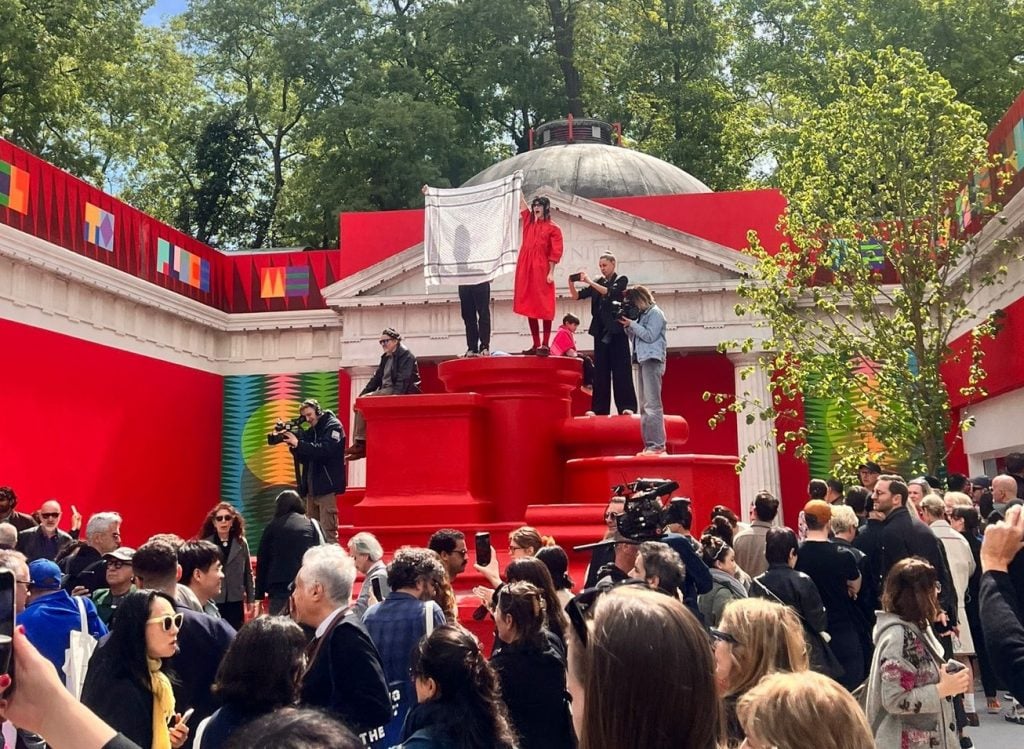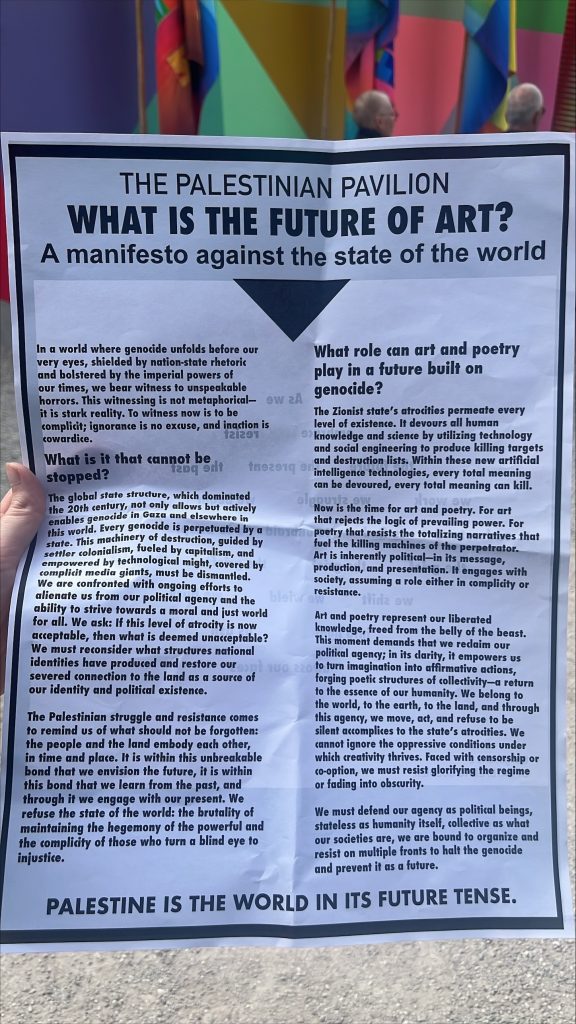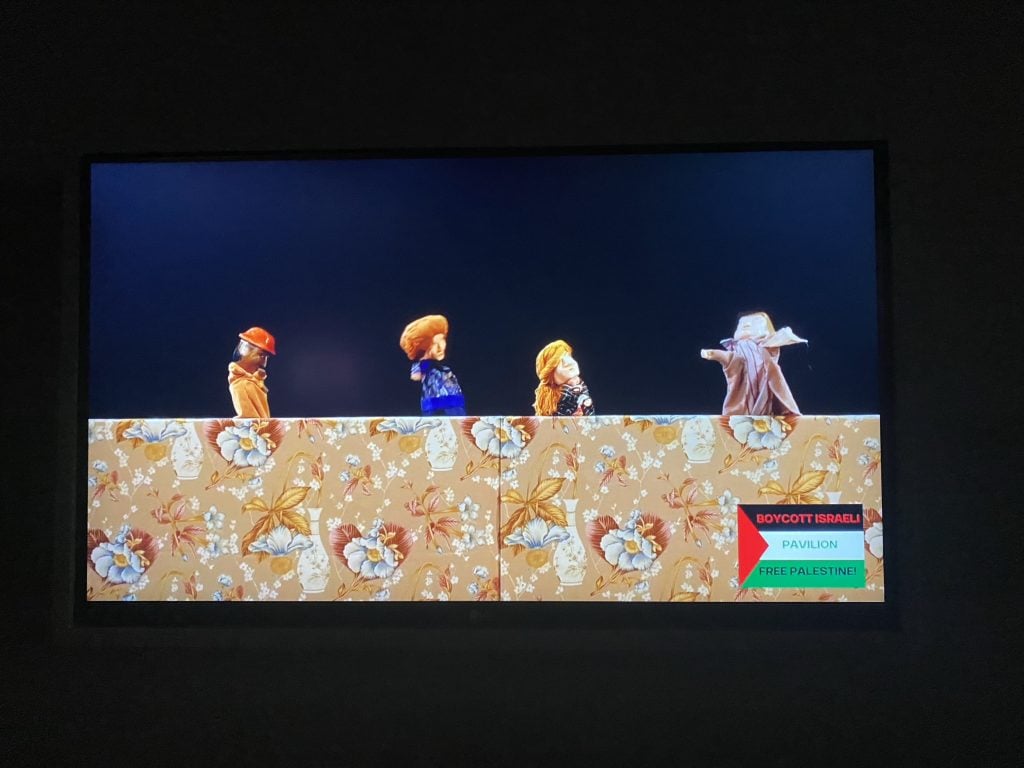Art & Exhibitions
Pro-Palestine Protestors Stage Demonstrations Across Venice
Around 100 protestors gathered outside of the Israel Pavilion demanding it be shut down "in its entirety."

Around 100 protestors gathered outside of the Israel Pavilion demanding it be shut down "in its entirety."

Margaret Carrigan

Pro-Palestine activists staged a protest at the Venice Biennale on Wednesday, April 17, calling for the complete closure of Israel’s pavilion, which remains locked after artist Ruth Patir, who is representing Israel, refused to open her exhibition and called for a ceasefire in Gaza and the release of Israeli hostages on Tuesday.
Around 100 protestors gathered outside of the Israeli Pavilion in the Giardini and moved toward other national pavilions, like those of the U.S., France, and Germany, chanting “stop the genocide,” “shut it down,” and “viva Palestina.” Flyers stating “No Death in Venice, No to the Genocide Pavilion” were also distributed. At the U.S. pavilion, which is next to Israel’s pavilion, protestors climbed on top of artist Jeffrey Gibson’s large-scale, outdoor concrete and fiberglass pedestals, waving a black-and-white keffiyeh.
Concurrently, across the city, a smaller group of protestors gathered on the famous Rialto Bridge, unfurling banners that read “Palestina Libera” and “the world is watching” while waving Palestinian flags.

Protestors on the Rialto Bridge. Photo: Margaret Carrigan.
The actions were led by the Art Not Genocide Alliance (ANGA), which issued a statement calling for Israel’s pavilion to be shut down “in its entirety.” Although Patir’s exhibition, “(M)otherland,” is fully installed and can partially be glimpsed through the windows, the building remains closed after she and the exhibition’s curators, Tamar Margalit and Mira Lapidot, posted a sign on the locked door on Tuesday, the first preview day of the biennale, stating that the show would not open to the public until “a ceasefire and hostage release agreement is reached.”
“ANGA does not applaud empty and opportunistic gestures timed for maximum press coverage, and leaving video works on view to the public, while Palestinians are killed by Israel every hour and millions face imminent famine,” the group said in the statement.
Patir did not respond to a request for comment. In a statement shared on Instagram on Tuesday, Patir said that she and the curators “have become the news, not the art.” She added: “I firmly object to cultural boycott, but since I feel there are no right answers, and I can only do what I can with the space I have.”

The Palestine Pavilion manifesto. Photo: Jo Lawson-Tancred.
Representatives of the Venice Biennale did not immediately respond to a request for comment about the protests or the current state of Israel’s pavilion.
ANGA has also been circulating a document that had been printed onsite at the biennial titled “The Palestine Pavilion: What is the Future of Art—A Manifesto Against the State of the World.” Accompanied by poetry, the manifesto calls for the dismantling of nation-states, “reclaiming land,” and restoring art as a central tool of resistance. Palestine does not have a pavilion at the event since Italy does not recognize it as a sovereign state; an official collateral event exhibition by the Palestinian organization Artists and Allies of Hebron has been named as one of 30 officially sanctioned collateral events.
Several artists taking part in the Venice Biennale have expressed support for Palestine in their work and installations. At Spain’s pavilion in the Giardini, the Peruvian artist Sandra Gamarra painted the words: “Transbody is to normative heterosexuality what Palestine is to the West: a colony whose extension and form is perpetuated only through violence.”

Daniela Ortiz, The Brightness of Greedy Europe (2022). Photo: Naomi Rea.
In the Arsenale, The Brightness of Greedy Europe, a video of a 2022 puppet theater staged by Peruvian artist Daniela Ortiz, features a small Palestinian flag in the corner of the screen that reads “boycott Israeli pavilion, Free Palestine!” Mexican artist Frieda Toranzo Jaeger’s large-scale painting and mixed-media work Rage Is A Machine In Times of Senselessness (2024) depicts watermelons, a symbol of Palestinian freedom and solidarity; the words “Viva Palestina” are lightly sketched into the flesh of one of the fruits.
Israel’s participation has been a point of contention among Palestine supporters. ANGA issued an open letter at the end of February that has since gained nearly 24,000 signatories. It states that “any official representation of Israel on the international cultural stage is an endorsement of its policies and of the genocide in Gaza.” Signatories include the photographer and activist Nan Goldin and artists representing other countries in the Biennale, including Chile, Finland, and Nigeria. ANGA did not immediately respond to an emailed request for comment.
In response to the open letter, Italy’s culture minister, Gennaro Sangiuliano, ruled out the possibility of barring Israel from the Biennale. “Israel not only has the right to express its art, but it has the duty to bear witness to its people precisely at a time like this when it has been attacked in cold blood by merciless terrorists,” the politician said.
Since Hamas’s attack on Israel on October 7 that killed 1,200 people and saw 240 taken hostage, and Israel’s ensuing war in Gaza that has killed more than 33,000 people, major protests, including boycotts, cancelations, and withdrawals, have been made at major events and venues in the art world.
Jo Lawson-Tancred provided additional reporting.